AMD's Richland vs. Intel's Haswell GPU on the Desktop: Radeon HD 8670D vs. Intel HD 4600
by Anand Lal Shimpi on June 6, 2013 12:00 PM ESTMetro: Last Light
Metro: Last Light is the latest entry in the Metro series of post-apocalyptic shooters by developer 4A Games. Like its processor, Last Light is a game that sets a high bar for visual quality, and at its highest settings an equally high bar for system requirements thanks to its advanced lighting system. This doesn’t preclude it from running on iGPUs thanks to the fact that it scales down rather well, but it does mean that we have to run at fairly low resolutions to get a playable framerate.
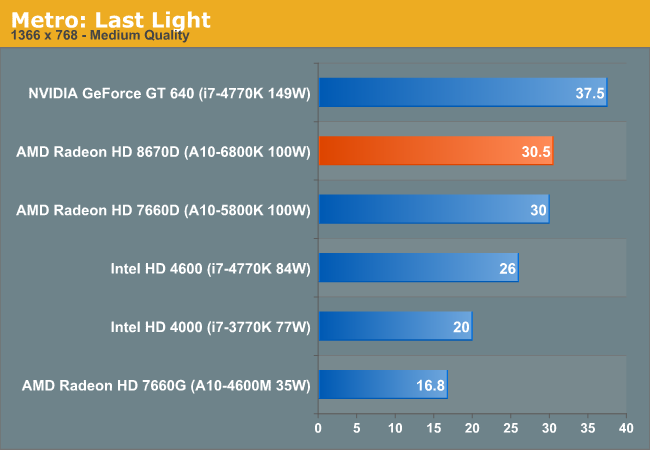
Looking at desktop parts alone, Intel really suffers from not having a socketed GT3 SKU. Although HD 4600 is appreciably faster than HD 4000 (+30%), both Trinity and Richland are around 17% faster than it. As you'll see, Metro ends up being one of the smaller gaps between the two in our suite.
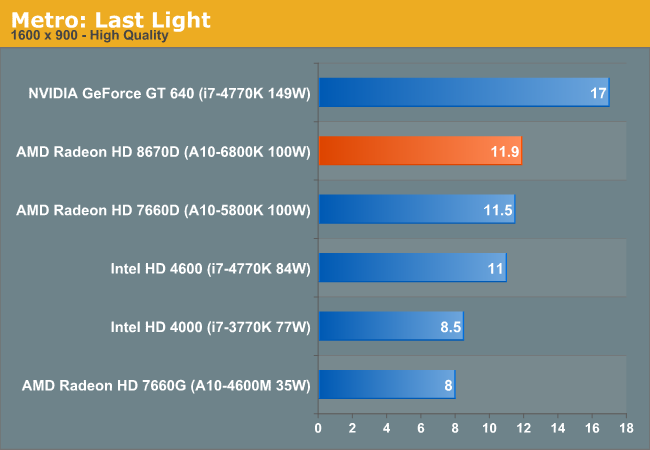
As memory bandwidth becomes the ultimate bounding condition, the gap between Richland and Haswell shrinks considerably. Note that on the HD 4600 side, the difference between DDR3-1333 and DDR3-2400 is only 10% here. Given the limited performance of the 20 EU Haswell GPU configuration, it doesn't seem like Intel is all that bandwidth limited here.
BioShock: Infinite
Bioshock Infinite is Irrational Games’ latest entry in the Bioshock franchise. Though it’s based on Unreal Engine 3 – making it our obligatory UE3 game – Irrational had added a number of effects that make the game rather GPU-intensive on its highest settings. As an added bonus it includes a built-in benchmark composed of several scenes, a rarity for UE3 engine games, so we can easily get a good representation of what Bioshock’s performance is like.
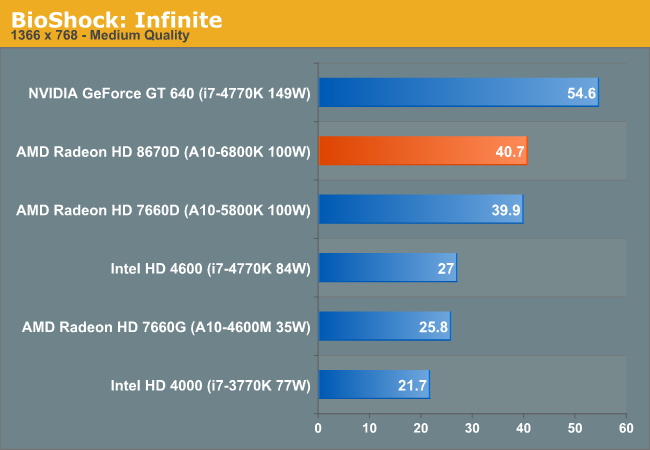
If Metro was an example of the worst case scenario for Richland, BioShock: Infinite is the best case scenario. Here the Radeon HD 8670D holds a 50% performance advantage over Intel's HD 4600 graphics.
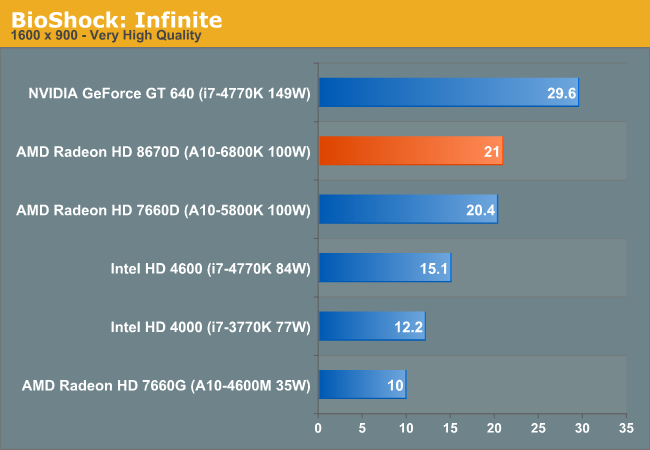
The gap narrows a bit at higher resolution/quality settings, but it's still 39%.
Sleeping Dogs
A Square Enix game, Sleeping Dogs is one of the few open world games to be released with any kind of benchmark, giving us a unique opportunity to benchmark an open world game. Like most console ports, Sleeping Dogs’ base assets are not extremely demanding, but it makes up for it with its interesting anti-aliasing implementation, a mix of FXAA and SSAA that at its highest settings does an impeccable job of removing jaggies. However by effectively rendering the game world multiple times over, it can also require a very powerful video card to drive these high AA modes.
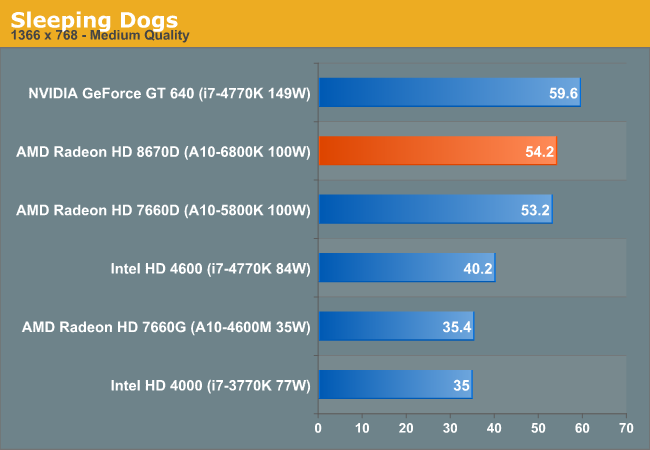
Richland is approaching 60 fps in our Sleeping Dogs benchmark at medium quality, definitely not bad at all. The advantage over Intel's HD 4600 is 34%.
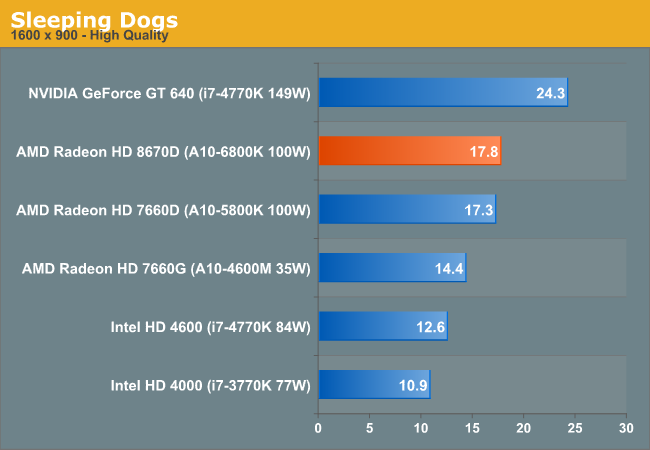
The performance advantage grows a bit at the higher quality/resolution settings, however we drop below the line of playability. With most of these games, you can trade off image quality for resolution however.
Tomb Raider (2013)
The simply titled Tomb Raider is the latest entry in the Tomb Raider franchise, making a clean break from past titles in plot, gameplay, and technology. Tomb Raider games have traditionally been technical marvels and the 2013 iteration is no different. iGPUs aren’t going to have quite enough power to use its marquee feature – DirectCompute accelerated hair physics (TressFX) – however even without it the game still looks quite good at its lower settings, while providing a challenge for our iGPUs.

Tomb Raider is another title that doesn't put Richland in the best light, but it still ends up around 23% faster than Haswell GT2.
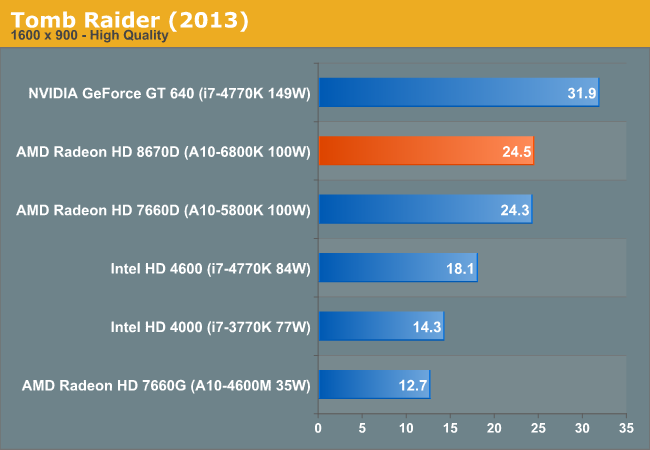
Battlefield 3
Our multiplayer action game benchmark of choice is Battlefield 3, DICE’s 2011 multiplayer military shooter. Its ability to pose a significant challenge to GPUs has been dulled some by time and drivers at the high-end, but it’s still a challenge for more entry-level GPUs such as the iGPUs found on Intel and AMD's latest parts. Our goal here is to crack 60fps in our benchmark, as our rule of thumb based on experience is that multiplayer framerates in intense firefights will bottom out at roughly half our benchmark average, so hitting medium-high framerates here is not necessarily high enough.
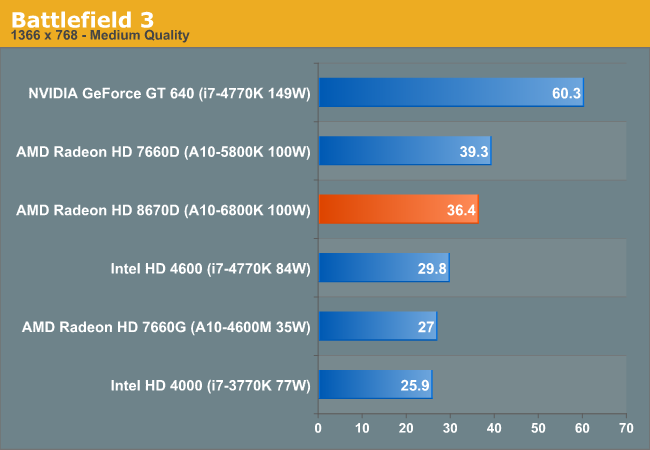
Richland's performance in Battlefield 3 climbs around 30% over the HD 4600 regardless of quality/resolution.

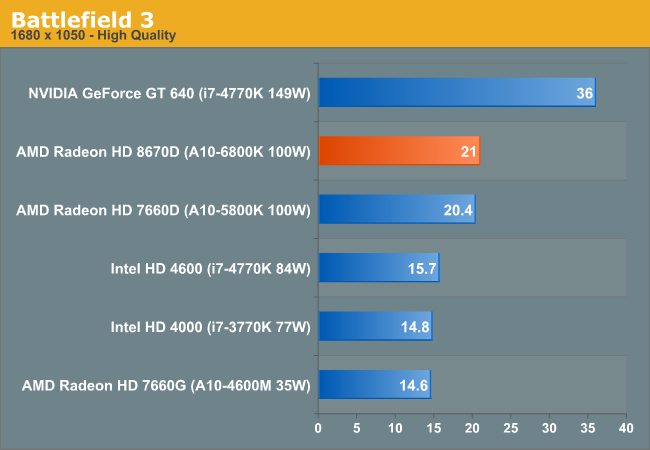
Crysis 3
With Crysis 3, Crytek has gone back to trying to kill computers, taking back the “most punishing game” title in our benchmark suite. Only in a handful of setups can we even run Crysis 3 at its highest (Very High) settings, and the situation isn't too much better for entry-level GPUs at its lowest quality setting. In any case Crysis 1 was an excellent template for the kind of performance required to drive games for the next few years, and Crysis 3 looks to be much the same for 2013.

Crysis is another benchmark where we see an increase in performance in the low 30% range.
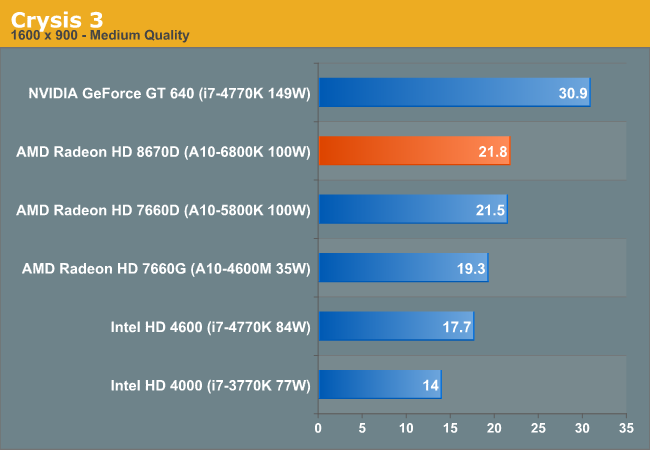











102 Comments
View All Comments
coder543 - Thursday, June 6, 2013 - link
Why are we not testing versus Crystalwell enabled Iris 5200? This is the most important information, even if it isn't in the same price category necessarily.testbug00 - Thursday, June 6, 2013 - link
Because that makes no sense as a testing point.The i7 tested is not in the same price gap ether (an i3 would probably lose a lot of this partial CPU stuff) but the iGPU performance barely changes.
And how is that the most important information????? If anything it is the least important as you cannot buy Iris (pro) iGPU 5x00 on desktop unless embedded.
JarredWalton - Thursday, June 6, 2013 - link
The bigger factor is that Iris Pro simply isn't available as a desktop part -- it's only available in the BGA package i7-4770R, which OEMs can use in things like all-in-one PCs. The other place where we'll see Iris Pro (for now) is on laptops with the HQ series parts, but again that's not going up against desktops. GT3 and GT3e effectively don't exist as desktop offerings right now, but that's not too surprising as laptops stand to benefit most from improved iGPUs.jeffkibuule - Thursday, June 6, 2013 - link
On the desktop, it's only in one SKU that's only for OEM systems.FriendlyUser - Thursday, June 6, 2013 - link
Let me remind you that the Iris5200 is a $650 part. In fact, the ONLY situation where the Crystalwell part makes sense is when TDP and power requirements/battery concerns are the absolute priority. Otherwise, it's much cheaper to get a non-iris part and a separate mobile gpu (say, radeon 8970M) that offers vastly superior performance.mikk - Thursday, June 6, 2013 - link
No this is wrong. Iris Pro starts at 440 USD in mobile. Crossfire is not comparable since you get horrible micro stuttering.Hrel - Thursday, June 6, 2013 - link
They fixed the stuttering a long time ago mikkGigaplex - Thursday, June 6, 2013 - link
It wasn't that long ago and it's still not completely fixed.Guspaz - Friday, June 7, 2013 - link
They improved the stuttering for single GPU use. Both nVidia and AMD suffer from micro stuttering with multi-GPU solutions. It's a different problem set.Samus - Friday, June 7, 2013 - link
AMD is worse than nVidia's stuttering, but is easily fixed by adding a third GPU. So instead of using two high end cards in Crossfire/SLI, using three mid-high end cards virtually eliminates stutter.